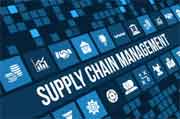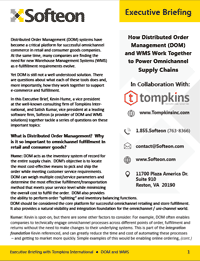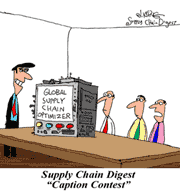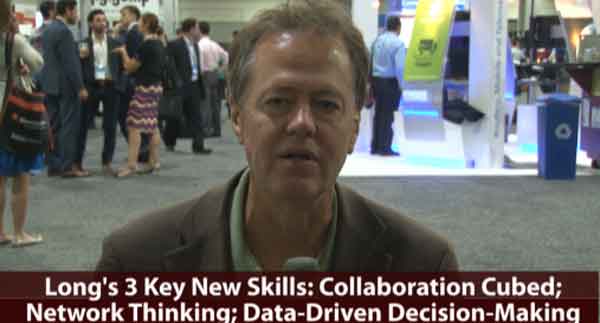 |
SUPPLY CHAIN NEWS BITES
|
What has Been the Growth in Spending on 3PLs?
|
|
 |
JB Hunt Says Truckload Rates Soon to Soar
|
 |
US PMI Jumps in September, in More Good Economic News |
 |
Warren Buffet Makes Big Investment in Truckstops |
 |
US Oil Exports Set Record |
|
|
|
|
|
|
Trip Report - MHI Annual Conference 2017
I first went to the MHI annual conference in 2014. That happened because at another industry event, my good friend John Hill of St. Onge and a now departed MHI exec sat me down and gave me a full court pitch as to why I should attend.
MHI had substantially revamped the conference, I was told, and it was moving from being focused on meetings among various MHI member groups and committees to one with a broader supply chain emphasis. Investments were being made.
I signed up and it was indeed a very fine event. I wrote at the time that given MHI's relatively fat coffers and its ambitions, other fall events such as the CSCMP and APICS conferences could possibly see some of their attendance peel off to this alternative over time.
| SHERMAN SAYS: |
Any presentation titled "The DC of the Future" is never, ever a thoughtful discussion about where DCs are headed when
WHAT DO YOU SAY?
Send us your
Feedback here
|
Do I still feel that way? I'll give you that answer at the end of this column.
So I am just back from the 2017 conference in lovely Boca Raton, FL. Before providing highlights of two days of keynote presentations and breakout tracks, just a little background. MHI, headquartered in Charlotte, is an industry association made up of providers of materials handling related solutions, from conveyor systems to WMS software to fork truck battery charging systems and everything in between. Unlike say CSCMP or WERC, membership is at a company not individual level, similar to NRF.
MHI (once the Material Handling Industry of America) is most known for producing the major ProMat trade show in Chicago every other year, and the MODEX show in Atlanta in the off years. There is no question that right now MHI is ambitious and looking to become more of a supply chain focused organization than just inward focused materials handling one. With sellouts at its shows and membership strong, it has some financial wherewithal to pursue that vision.
The MHI conference has been around for decades, and was primarily a chance for its various sub-groups, organized around different product/solution areas, to meet and discuss programs, wrapped around a few external speakers to provide some diversion. Then, the decision in 2014 to expand the conference and up the content level and quality.
With that background, the most interesting session I attended was one on disruption and ultimately self-motivation by David Roberts, a young, incredibly accomplished tech industry entrepreneur and a fantastic speaker.
By way of definition, Roberts says innovation is about doing existing things better, whereas disruption is about new things that make existing things obsolete. That's kind of interesting. He added that with innovation, customers generally know what they want, whereas with disruption customers don't know – who, for example, was calling for Uber before it came along?
Roberts does not believe disruption thinking can develop in existing R&D groups/processes, because the disruption might threaten the company's current ways of operation – "the antibodies will come out to protect the status quo." He said for major disruption thinking, a few companies have created "empty" organizations that they start moving people into, as a way of reinforcing the need for old thinking to be put on a shelf.
I have a left a ton out, but Roberts ended with an interesting observation. The world overall doesn't have a shortage of food or water, yet people are starving or getting sick from bad water. What we have instead is a shortage of "moving" – getting those materials to where they are needed. Hence there is a huge opportunity for the supply chain to make a real difference in the world. We need more to step up.
The next best presentation was by Bill Best, VP of supply chain at outdoor retailer REI, an interesting company for sure that operates as a co-op. It has lived sustainability since its founding decades ago, and frankly puts "purpose before profits."
Best made a strong case that sustainability was simply the right thing to do, but emphasized that it was eminently possible to run a good business at the same time, as REI has demonstrated.
And that's in part because the evidence is increasingly clear that customers want to do business with sustainable companies and products. |
 Best went through a long list of on-going REI efforts, from sourcing to packaging. It reuses cartons sent to its stores several times in the DC before recycling, for example, and Yes, some have problems traveling well on the conveyor. But do you kill a great program because a small percentage of cartons have issues? No, Best said. Best went through a long list of on-going REI efforts, from sourcing to packaging. It reuses cartons sent to its stores several times in the DC before recycling, for example, and Yes, some have problems traveling well on the conveyor. But do you kill a great program because a small percentage of cartons have issues? No, Best said.
The main focus on the presentation was the nearly $80 million new DC REI recently built in Goodyear, AZ. It was simply designed for sustainability from the get-go, which included getting all the key players (developer, architect, contractor, materials handling vendors) together and working as a team very early on.
Features include 100% of power needs met by solar panels on the roof, some kind of new age water-cooled air conditioning system that sits on ground level, leaving needed room for the solar panels on the roof, LEED platinum certification, conveyor motors that use less power, etc. Great story.
This one of the two best sustainability presentations I have seen in recent years (along with one from Richard Murphy of Murphy Warehousing), one that came from the heart with credibility, and was persuasive without hype, dire climate warnings, or lecturing. There is always an open door for anyone, competitor or not, to visit the Goodyear DC. Just give Best a call. We must "open source" sustainability to make faster progress, Best says.
I have learned many things in years of covering conference presentations, and one is this: any presentation titled "The DC of the Future" is never, ever a thoughtful discussion about where DCs are headed when. It is always about what is happening right now – you can take that to the bank.
Panelists for the MHI version included Todd Farwell of Caterpillar, and interesting guy I have heard speak before, and Jason Morin of medical supplies distributor Owens & Minor. There were also two technology vendors on the panel, leading to some grumping afterward that there was too much commercialism.
Here were the two most interesting panel observations. The first was actually from an attendee, who said he has visited many very highly automated DCs around the country, and for the most part found adopters disappointed with the result. Is that an accurate characterization or not – and what does it say about the DC of the future? That would have been a great topic for the right panel to explore.
Second, Farwell noted that Caterpillar has really rethought its approach to distribution. In today's dynamic, unforecastable world, if you spend millions and maybe three years to design and construct a new facility, chances are demand patterns have changed, needs have changed, etc. by the time the facility opens.
So Cat is now embracing a new approach that focuses on securing space more closely to when demand is known, which implies greater use of outsourcing (and maybe with shorter contracts), along with leveraging a company like FLEXE, which aggregates short-term, rentable space from existing warehouses across the US.
There is some goodness in this approach, I told Farwell, but it also really precludes leveraging scale and automation. Farwell though it likely that the third parties would provide automation to reduce costs, but I think that will turn out to be at best partially true. I would be curious on your take on Cat's new thinking.
There is more but I am out of space, other than to note from a panel on talent development that both Target and Walmart (as well as two smaller companies) are getting a lot more focused on local community colleges, tech schools and in some cases even STEM high schools to partner produce the type of DC technicians or field service techs they need. They keys are just consistent dialog, recognizing terminology differences (Target is just now changing titles in its DCs from "mechanic" to "automation technician" or similar), and pushing local DCs managers to take a proactive role in working with the schools. Decentralized approaches work best, Target and Walmart say.
I had a good couple of days overall at MHI and will likely be back in 2018, but the content was frankly a mix of the good and the not so food. Not really much progress, if any, from 2014, and little if any growth in non-MHI attendees. To be any kind of threat to the existing world conference order, MHI will have to rethink the program and structure – and spend some serious money.
Any reaction to the presentation summaries provided by Gilmore? What do you think of Cat's new approach to distribution? Let us know your thoughts at the Feedback button below. |

|
 |
|
| |
|
|
October Videocast: |
Supply Chain Optimization Predictions and Misses: A Look at Back at Optimization Trends in 2017 - Where We're Headed in 2018
|

|
A Look at How Events this Year Impacted Supply Chain Design and Optimization - and How You can Be Ahead of the Curve in 2018
A look at unforeseen events of 2017 - and how they impacted supply chain practice, as well as, a discussion in key trends that we can expect in optimization in 2018 and beyond.
Featuring LLamasoft EVP Toby Brzoznowski and Supply Chain Digest Editor Dan Gilmore.
|
 |
| Wednesday Oct. 11, 2017 |
|
On Demand Videocast: |
How DOM and WMS Work Together to Power Omnichannel Supply Chains
|
 |
Experts from Tompkins International and Softeon Set the Record Straight in Fast Paced, Q&A Format
This discussion will be based on an outstanding new "Executive Brief" on this same topic, developed jointly by Kevin Hume of Tompkins International and Satish Kumar, a vice president at Softeon.
Featuring SCDigest editor Dan Gilmore, Kevin Hume of well-known consulting firm Tompkins International and Satish Kumar, a vice president at Softeon.
|
 |
Available On Demand |
|
On Demand Videocast: |
New Cloud WMS Solution is Game Changer for Warehouse Management Deployment and Flexibility |

|
New Technology and Deployment Approach Offer a Simply Better Way to WMS Implementations - Learn How
In this outstanding Videocast, we will cover the latest in each-picking robotics, co-bots, artificial intelligence, autonomous vehicles, sensors, drones and droids.
Featuring Dan Gilmore, Editor, along with Mark Hawksley and Bruno Dubreuil of TECSYS, a leading provider of WMS solutions.
|
 |
| Available On Demand |
|
|
Feedback on US Inventory Performance 2017

We have recently published a white-paper within our organization that talks about principles to Inventory Optimization and how Digital levers could be helping the same in the next few years.
As part of this we seem to be having an analysis of the 2 fundamental reasons of increasing Inventory in the last few years.
The gap between Demand Curve & Supply curve has been widening – this is observed due to certain symptoms such as Excess, Buffers, Inadequate replenishments, high purchase quantities, conservative Reorder points, etc. which in turn can be correlated to underlying causes such as long lead times and high lead time variability, infrequent inventory level checking, lack of ABC classification or its usage, and so on.
Sameer Shukkla
Consulting Partner
WiPro

|



![]()

![]()

![]()








 Best went through a long list of on-going REI efforts, from sourcing to packaging. It reuses cartons sent to its stores several times in the DC before recycling, for example, and Yes, some have problems traveling well on the conveyor. But do you kill a great program because a small percentage of cartons have issues? No, Best said.
Best went through a long list of on-going REI efforts, from sourcing to packaging. It reuses cartons sent to its stores several times in the DC before recycling, for example, and Yes, some have problems traveling well on the conveyor. But do you kill a great program because a small percentage of cartons have issues? No, Best said.

